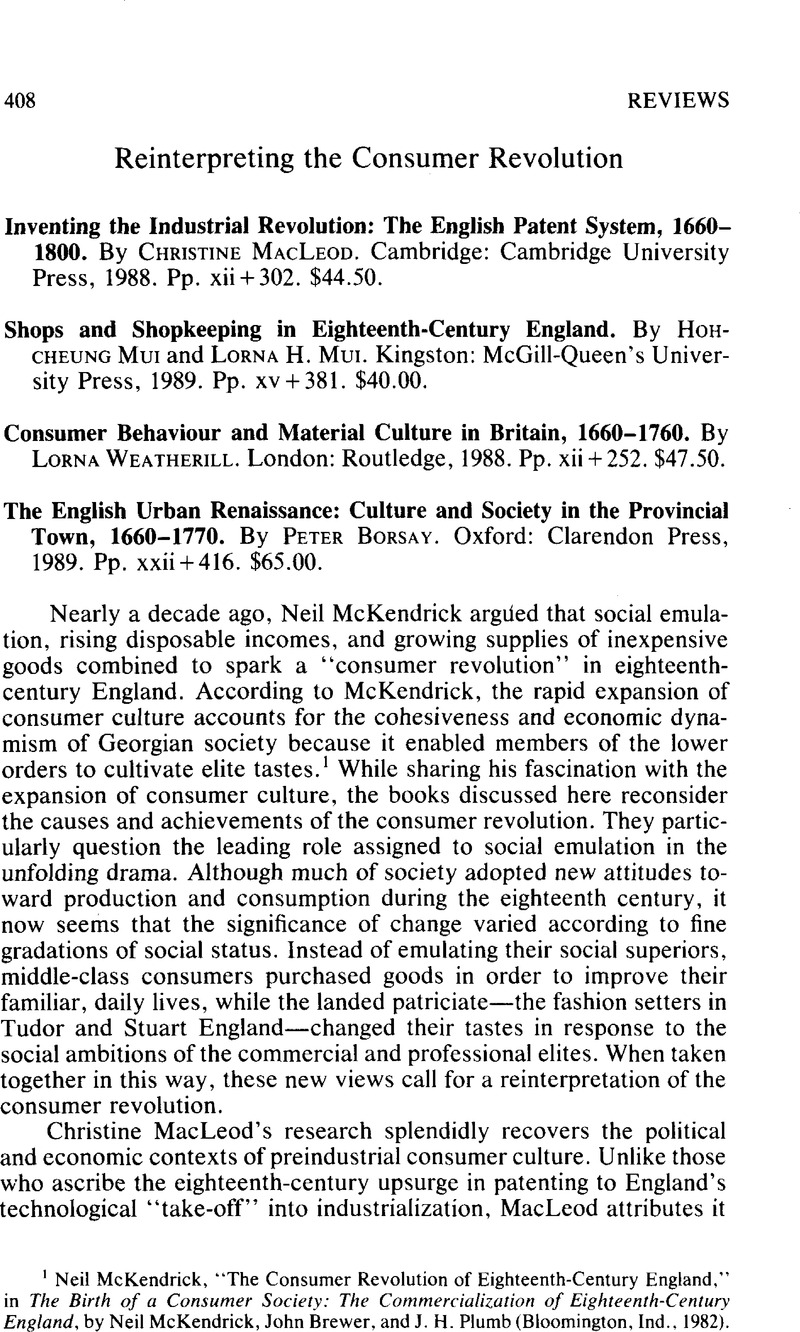Article contents
Reinterpreting the Consumer Revolution - Inventing the Industrial Revolution: The English Patent System, 1660–1800. By Christine MacLeod. Cambridge: Cambridge University Press, 1988. Pp. xii + 302. $44.50. - Shops and Shopkeeping in Eighteenth-Century England. By Hohcheung Mui and Lorna H. Mui. Kingston: McGill-Queen's University Press, 1989. Pp. xv + 381. $40.00. - Consumer Behaviour and Material Culture in Britain, 1660–1760. By Lorna Weatherill. London: Routledge, 1988. Pp. xii + 252. $47.50. - The English Urban Renaissance: Culture and Society in the Provincial Town, 1660–1770. By Peter Borsay. Oxford: Clarendon Press, 1989. Pp. xxii + 416. $65.00.
Published online by Cambridge University Press: 10 January 2014
Abstract

- Type
- Reviews
- Information
- Copyright
- Copyright © North American Conference of British Studies 1990
References
1 McKendrick, Neil, “The Consumer Revolution of Eighteenth-Century England,” in The Birth of a Consumer Society: The Commercialization of Eighteenth-Century England, by McKendrick, Neil, Brewer, John, and Plumb, J. H. (Bloomington, Ind., 1982)Google Scholar.
2 For more on these topics, see Porter, Roy, “Science, Provincial Culture and Public Opinion in Enlightenment England,” British Journal for Eighteenth-Century Studies 3 (1980): 20–46CrossRefGoogle Scholar; Jacob, Margaret C., The Cultural Meaning of the Scientific Revolution (Philadelphia, 1988)Google Scholar.
3 Their work does not allow the Muis to build on research into seventeenth-century retailing, such as Thirsk, Joan, Economic Policy and Projects: The Development of a Consumer Society in Early Modern England (Oxford, 1978)Google Scholar; and Spufford, Margaret, The Great Reclothing of Rural England: Petty Chapmen and Their Wares in the Seventeeth-Century (London, 1984)Google Scholar.
4 Breen, T. H., “An Empire of Goods: The Anglicization of Colonial America, 1690–1776,” Journal of British Studies 25 (1986): 467–99CrossRefGoogle Scholar, and “‘Baubles of Britain’: The American and Consumer Revolutions of the Eighteenth Century,” Past and Present, no. 119 (1988), pp. 73–104Google Scholar.
5 Boston Gazette (May 29, 1758).
6 Weatherill builds on the ideas and terminology of Goffman, Erving, The Presentation of Self in Everyday Life (Harmondsworth, 1969)Google Scholar.
7 For more on the diversity of the middle-class domestic economy, see Earle, Peter, The Making of the English Middle Class: Business, Society and Family Life in London, 1660–1730 (Berkeley, 1989)Google Scholar; Davidoff, Leonore and Hall, Catherine, Family Fortunes: Men and Women of the English Middle Class, 1780–1850 (Chicago, 1987)Google Scholar; Smail, John, “From the Middling to the Middle: Class Formation in Halifax, Yorkshire in the Century before the Industrial Revolution” (Ph.D. diss., Stanford University, 1988)Google Scholar.
8 Borsay's analysis of the attitudes of the professional and commercial elites toward the traditional patriciate is in marked contrast to that of Thompson; see Thompson, E. P., “Patrician Society, Plebeian Culture,” Journal of Social History 1 (1974): 382–405CrossRefGoogle Scholar, and “Eighteenth-Century English Society: Class Struggle without Class?” Social History 3 (1978): 133–65CrossRefGoogle Scholar.
- 1
- Cited by




